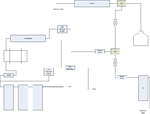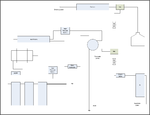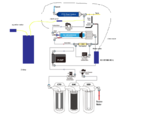looking at your schematic, i would venture to say you might have some issues in that the output pressure of membrane #2 will equal the output pressure from membrane #1. logic would dictate that a pressure valve will prevent #2 from backwashing into #1. the check valve can only be open or closed however so whatever membrane has more pressure will be the primary (and only) membrane in use. maybe someone can confirm?
Yes, logically it would make sense. The only way to get equal pressure is to run them in parallel, but you aren't using the reject water to the second membrane. I think you would need to have a boost pump to make the second membrane more efficient or design it with permeate pumps and a higher rated boost pump after the pre-filters.
I haven't put in the second membrane yet, I want to test this solution first then try with a permeate pump (below). I did some modifications because the DI output was draining my refrigerator supply (water tank) . I either have to get a larger tank or put a ball valve (BV) in place when I'm creating DI water. (see diagram below)

My only issue right now is water pressure to the refrigerator is low. I might install a permeate pump to help increase the pressure or get a larger booster. I think the system I had was for 75gpd and the booster pump probably didn't push more than 60 psi (need another pressure gauge), I think Brett's pump has a higher output rating that he dialed in.
I might test this out with the Permeate and looking for one if someone has one. I may have spoken with
@Buckeye Hydro about this, but it was suggested that permeate pump might be a better solution to the pressure problem and waste water. This is all a science experiment just to get better performance and less waste water. My TDS is at 220 (tap), 9 (after membrane) and 0 (after DI)




















